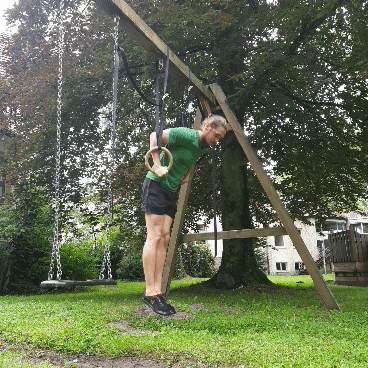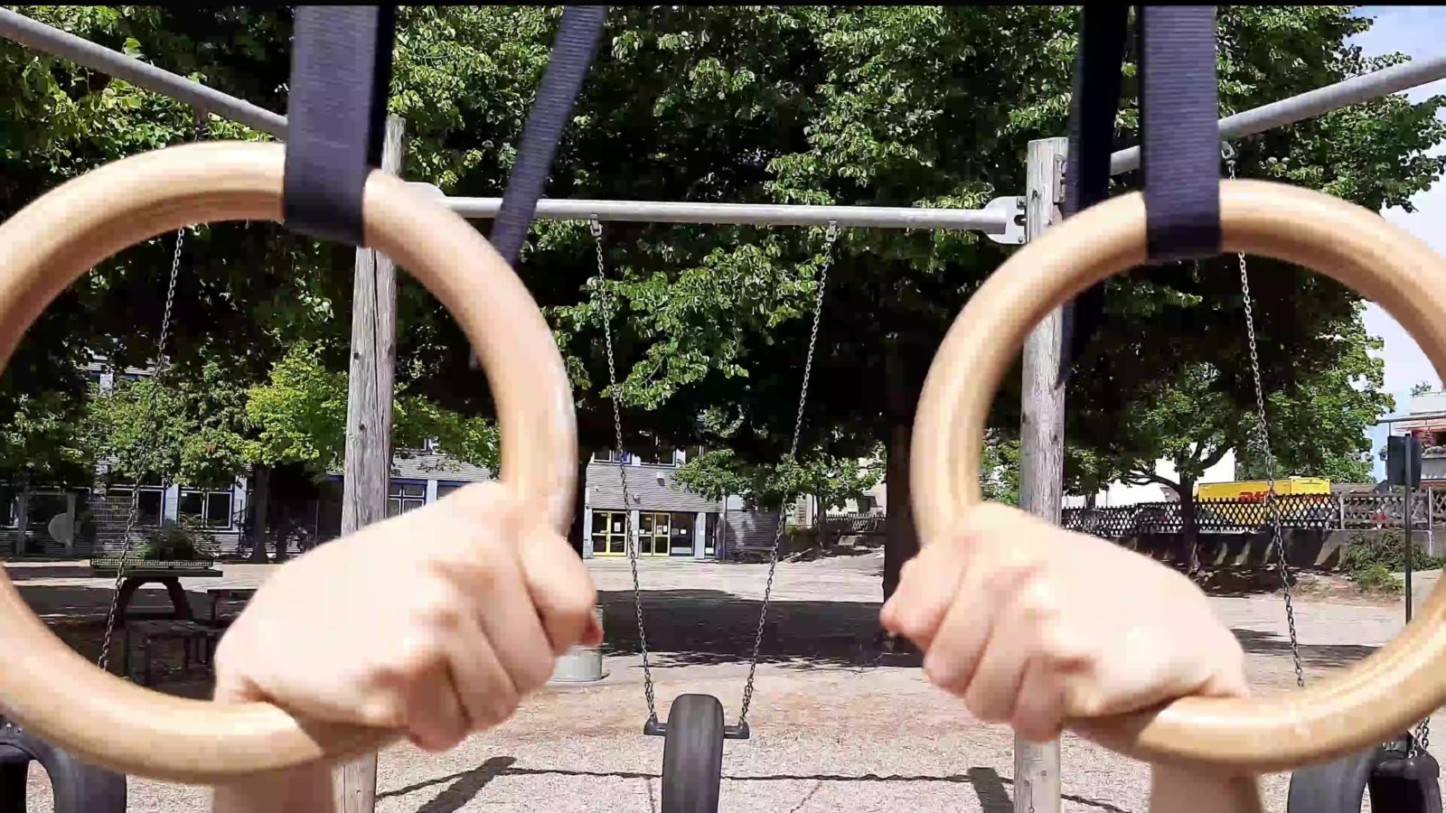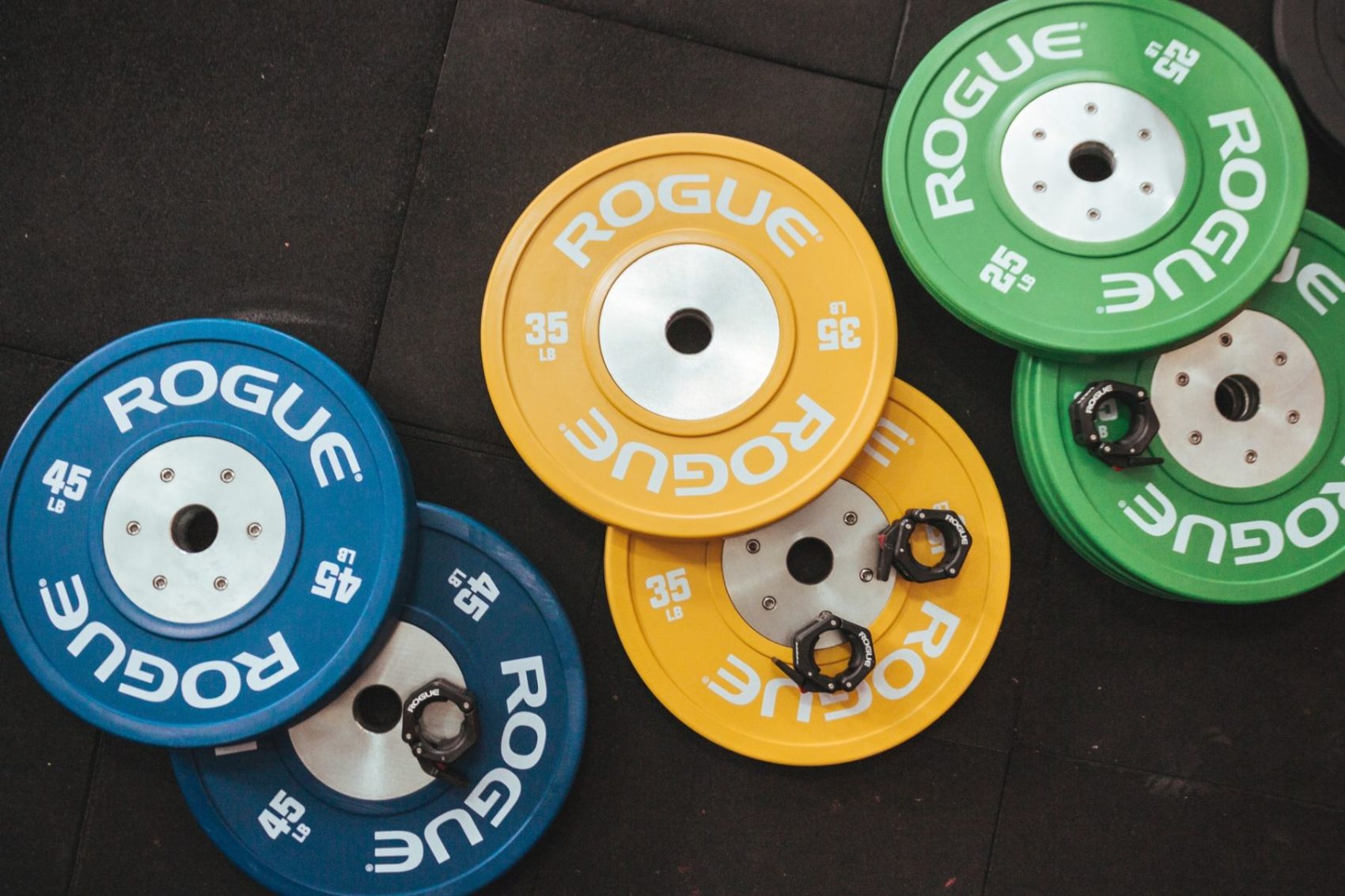For most, the Muscle Up is the first, brightly shining skill to achieve, when they start Calisthenics. Beyond the basic moves as dips, pullups, and Co, it is the next logical step and an appropriate intermediate goal.
Rightly so! It isn’t that hard to learn and doable for anyone. Your body composition doesn’t wildly interfere with it1, you need a solid foundation – nothing superhuman, and therefore the journey shouldn’t take years.
Within this post, we’ll look at this simple move in every detail! What parts make up the Muscle Up as a whole, how to build up the real deal, and a sample routine. But first – let’s look at what the right starting point might look like!
Prerequisites for the Muscle Up
Fundamental Pull Strength: Pullups
To successfully Muscle Up you need to get above the bar* – this demands a solid foundation of pulling strength – or a stupidly insane amount of momentum. We’ll talk later about why momentum should be the last option to help you. For here, let’s say that brute strength, paired with solid technique is the preferred way to go!
10 Chest-to-Bar Pullups or 5 High Pullups on Rings – preferably using the False Grip – would be the minimum starting point. Being stronger makes the journey easier and maybe shorter, but isn’t necessary for a single rep.
You can learn all about correct Pullups here.
Fundamental Pushing Strength: Dips
Beyond a solid pulling foundation you need a good vertical push!
I would aim for 5 deep Ring Dips without your elbows flaring out, plus a comfortable 30s Ring-Turnout Support Hold. Then a Muscle Up on Rings* should be fine regarding this point.
If you wanna Muscle Up on Bars, 10 Bar Dips are a goal to aim for. But we’ll talk later on more about Bar vs. Ring Muscle Ups and which one you should work on optimally.
If you want to learn more about dips read this dedicated post.
The False Grip
Despite pushing and pulling strength you need the False Grip. Without it, the move gets significantly harder. The False Grip is the often overlooked piece when it comes to Muscle Ups and sets beginners up for a hard and frustrating start.
This Grip enables you to comfortably switch from a pullup into a dip. Otherwise, you often get the feeling that you can’t initiate the dip, no matter how high you pull.
- Train it on bars and rings, depending on your ulterior goal.
- Progress carefully.
- Train Rows, Hangs, and later on Chinups using the False Grip to build up the necessary strength in this position.
At first, it is an awkward position, which hurts painfully at the outer part of your wrist joint2, later on, it will come second nature!

Let’s break down the Muscle Up into its most basic parts!
Different Muscle Ups in different Sports
Many Sports use Movements like it – think of CrossFit, Calisthenics, or its father Gymnastics. More interestingly each of them molds the Muscle Up for their specific purposes:
- CrossFit for max reps with momentum and much hip drive
- Calisthenics as a skill or to get momentum for freestyle moves
- Gymnastics simply to get upon the rings into the Support Hold or strict & wide as Bent-Arm Conditioning
Mostly, I will talk about the Muscle Up on Rings – first with momentum and later with the goal to get them strictly done. Simply, because that is what I found the easiest way to learn the movement.
First learning it, then improving it, and then adding variation – like the bar Muscle Up.
Let’s look at the first part of this move – the grip!
The Right Grip
Both above won’t get you far, unless you grip the rings* – or bar – rightly, using the False Grip. The False Grip is the basic grip one uses in gymnastics, when below the rings.

The Rings rest onto the outer part of one’s wrists with the wrists flexed. This is a very uncomfortable posture at first. It puts a lot of pressure onto the wrists and your forearm flexors. But with time and practice comes comfort, be assured!
By using this grip, you are able to land in a stable bottom position of a dip – because your hands are already wrapped around the bar before you even initiate the pullup.
For more detail on the False Grip watch this in-depth tutorial by Sid Paulson. And remember to start slowly. Don’t be a hero when it comes to false grips – elbow tendonitis lurks at bay for those who try to rush it:
- Load it gradually (Rows – Hang – Chinups)
- Train it regularly (Use False Grip exercises as Finisher)
- Look at the signs your body gives you
A High Pullup
To get on top of the rings you need to have a decent vertical pull. 5-10 solid Chest-to-Bar Pullups should be fairly enough.
Endlessly training explosive pullups and Chest-to-Bars isn’t the way to go. I would spend my time more wisely on improving your transition and repping out the real deal!
The Transition

Here comes the most important part of the Muscle Up. While pulling and pushing is solely about brute force, here comes the skill part into play!
You need to train the transition on its own, to get it done efficiently. It is important to keep the elbows as close as possible towards your trunk.
The more your elbows flare out, the harder the Muscle Up gets – unnecessarily. Unless you are a beast and wanna train wide Muscle Ups.
A Deep Dip
Likewise, a solid Dip-Foundation is necessary, but repping out endless dips isn’t the way that will get you to rep out Muscle Ups. Build up to 5 beautiful Ring Dips, as well as a solid Ring-Turnout support hold.
Beyond that, you should work on your mobility. The deeper your dip is, without insanely flared out elbows, the deeper you can transition into it.
And finally – The Support Hold

This is the position each rep should end with. A nice and clean Ring-Turnout Support Hold. As the rings are a tricky and unstable piece of equipment, training support holds on their own makes sense, too.
Aim for a stable hold of ~30s and you should be on the safe side.
One additional thing that could help in the beginning is a slight hip drive:
Although I am no fan of kipping Muscle Ups – we are in for the mostly straight real deal. The strict one. To learn it using a bit of momentum is fine. Better to do one half-*** Muscle Up than none. Perfection comes afterward.
The most of the momentum comes from the combo of a high pullup paired with a slight hip drive – likewise when you would deadlift.

Muscle Up Routine
I would train this routine two times a week preferably on bent arm days, as the Muscle Up interferes with push and pull days. That’s why I prefer to choose a Bent-Arm/Straight-Arm split when the Muscle Up is your goal instead of a basic push/pull/legs split.
Warmup:
- General Cardio
- Warmup your wrists, shoulders, and false grip specifically.
- 1x5r Pullups & Dips.
- 1x30s RTO Support Holds
Muscle Up Progressions (Choose 1 and do it for 5×3-5r):
Pullups (3×5-8r):
- Just basic ring pullups – if you’re able to do it choose the false grip
Dips (3×5-8r):
- Deep Dips – hold the support hold for ~5s on each rep
Transition Progression (Choose 1 and do it for 3x3r):
- Rowing Transition
- Negative Muscle Up Transition
- Full Transition
False Grip Finisher (Choose one and do it for 3x10r or 3×30-60s):
| Warmup | Muscle Up | Pullup | Dips | Transition | Finisher |
|---|---|---|---|---|---|
| General + Specific | Choose a level and perform 5x3r | 3×5-8r | 3×5-8r | Choose a level for 3x3r | 3x10r or 3×30-60s |
| Prime the movement you wanna pratice | Aim for technique and try to understand the motion | Do them in a neutral or false grip | Hold each rep at the top | Push yourself and strengthen this difficult movement | Strengthen the false grip and get used to it |
The most common Mistakes when it comes to the Muscle Up
Not False-Gripping
Improve your false grip and strengthen it specifically. The FG Hang and Chinup will be your best friends the next few weeks. It is easy as that. But don’t overdo it!
When you miss out on the false grip the move will get harder and make you relying on momentum to have the time to switch the grip from a pullup grip into a stable dip grip. That works with much of momentum, but will be an issue later on when it comes to strict Muscle Ups.
Not getting over the Rings
If you lack the pulling power – you can work around that issue with a bit of well doses momentum. Don’t *** your way upwards – rather engage the pullup explosively, explode at your hips, but land with intent in a deep dip. Reverse the movement slowly and exaggerate the negative part.
Landing in an unstable Deep Dip:
Often this happens for flexibility reasons. You simply lack it or aren’t strong in that bottom position. The most convenient way to fix this is to exaggerate this bottom portion of your basic dips. Stay in that position for 5s on each rep and try to really feel the stretch – go deeper each rep and keep your elbows tight.
Another great exercise to fix shoulder extension is skin the cats – think about doing them in this case as part of your warmup.
Muscle up on Rings vs. Bars
As previously said – both variations are roughly the same but differ in some points. Same same, but different.
Generally, bar Muscle Ups* are much harder, especially when done strictly. This is because the rings* can move around freely and allow more workaround solutions your body comes up with than the rigid piece of stainless steel.
Beyond this important difference, in the bar muscle up your elbows need to flare out more. Your pullup will look wider and your dips have to be wider. Your arms land in a significantly more internally rotated position.
While internal rotation is no issue per se, it can be an issue if you lack internal rotation or are weak in that particular position. That’s why most insanely strong, but often stiff, calisthenics bros wreck their shoulders repping out Muscle Ups. This reason is why I prefer to learn the ring Muscle Up first.
For more detail on flexibility check out Thomas Kurz Stretching Scientifically.*

Helpful exercises when learning the Muscle Up
Banded Muscle Up
The banded Muscle Up* takes a set weight of yours out of the equation. It is a great way to get a feeling for the real deal!
The setup of the band can be a bit tricky though. Pardal did a great Tutorial over at Instagram on how to set it up properly – without flinging it back onto your ***.
Negative Muscle Up
Likewise the previous exercise, the negative enables you to practice the whole movement. I build up the full muscle up aided solely by eccentrics and toe support.
I would advise anyone to try out the eccentrics. The most important part here is to go really slow.
False Grip: Rows, Hang, Chinups
The False Grip is a pain in the ass at the beginning – it is a really uncomfortable position. Unfortunately it offers many benefits and there is ahrdly a way around it.
I found the best way to build up your false grip capacities is to load it gradually and use it on different exercises you already do – like rows, hangs and later on chinups. Some time in, it will be second nature!
Front Lever to Muscle Up
I found this move really interesting to play around with once you can strictly Muscle Up. Going from a tuck front lever to a deep dip and vice versa feels interesting and challenges your muscles very unqiuely.
Have a look at AramaMovement demonstrating them with grace.
Weighted Muscle Ups
What’s better than one Muscle Up? One Muscle Up with 5 additional kilos*! I never loaded it up yet, but many others made great progress with these. I would suggest wearing a weight vest* or ankle weights* to load this complex movement up.
But as with any loaded calisthenics movement – listen to your body and only load the movement when your technique is solid!
For all these progressions I can fully recommend Steven Low’s Overcoming Gravity*. In this bodyweight-strength centered book, he breaks down every skill down to its progressions – from novice level to superhuman.
The Muscle Up is useful!
And finally – you can use it to get on top of the rings. Originally that’s its whole purpose in gymnastics – to get into a ring support. Nothing fancy at all.
That’s why using it often in your training – after you’re comfortable with that movement – can make a big difference.
And here I wanna end today’s long-*** post. Thanks for staying with me until down here, man. Really! I took a long road to finally muscle up, but in retrospect learned much about the movement – I hope it could help you out at some point in your journey!
If you need some additional help write your question down below, get in contact or consider hiring my services and I will do my best to keep you on the right path.
And with this shameless adversation at the tiny bottom of that endless post I end up and say bye! I bet every marketing guy is smashing his face right now into something. 😀
Anyways, enjoy your Muscle Up journey! You will get there, inevitably!

Sources and further reading:
- False Grip:
Sid Paulson did an awesome video on the False Grip and how to train it. He covers hangs, rows and chinups, as well as the entire technique part in it. - Muscle Up
Great videos on the Muscle Up itself are these two by GMB Fitness and Tom Merrick – they hit on them from nearly every angle.






